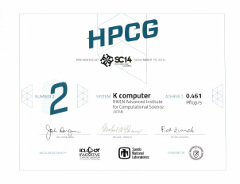
On November 20, the K computer took second place in the HPCG benchmark, a new index developed to try to create a more realistic view of supercomputer performance compared to the LINPACK benchmark that is commonly used.
The HPCG (High Performance Conjugate Gradient) benchmark measures how fast a computer can solve symmetric sparse linear system equations using the conjugate gradient method preconditioned with a multi-grid symmetric Gauss-Seidel smoother. Problems of this type are typically encountered in actual engineering and industrial applications, and require a balance between calculation performance, memory performance and communication performance, unlike LINPACK, which looks at calculation speed alone.
For this competition, 82,944 of the K computer's 88,128 cores were used, achieving a performance of 460.754 teraflops.
According to Jack Dongarra of the University of Tennessee, who contributed to the development of the new benchmark, "The K computer has produced very impressive results on the new HPCG benchmark listing. The performance achieved puts the K computer at position two on the list. The results show that the K computer has a very balanced architecture for dealing with some of the most challenging computational science problems. Congratulations on the performance achieved."
The awards were presented at the SC14 high-performance computing conference in New Orleans.
